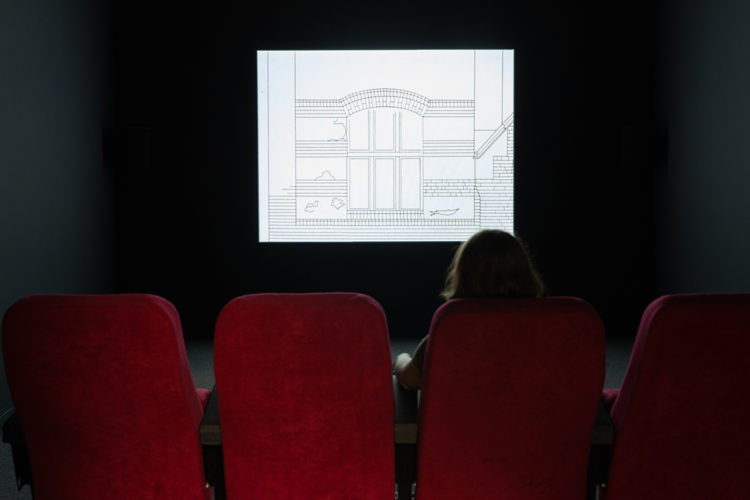
Exhibition view, Harun Farocki, Images of the World and the Inscription of War / Bilder der Welt und Inschrift des Krieges, 1988, 16mm film, color, with sound, 75’. Photo credit: infi.ro
Looking back, Harun Farocki showed himself as one of those freewheeling artists who did a bit of everything – press, activism, agitprop film, television, cinema, video art, installation. Coincidentally, I do not have firm preferences when it comes to his work; I equally enjoy his observational documentaries as well as the installations he created with Antje Ehmann. The opportunity to get closer to his artistic career offers a valuable case study – because, by all accounts, the media changes did not come of the filmmaker’s own accord, but from his need to adapt to the market. It’s precisely this versatility that makes Farocki so relevant to me these days (months!), when the restriction measures are more permissive with the exhibition spaces than with cinemas, allowing me more time to reflect upon the ways of making, seeing and displaying moving images. Species of spaces.
Diana Marincu, the curator of the exhibition Harun Farocki – Reality Would Have to Begin (Art Encounters, Timișoara, 01.-31.10.2020), had a similar interest herself. Bringing together films-essays, videos, and installations made by Farocki between 1980-2014, the curator took care to preserve their initial medium, and even to simulate two cinema set-ups for displaying Images of the World and the Inscription of War / Bilder der Welt und Inschrift des Krieges (1988) and Respite / Aufschub (2007). This may seem small, just some artifices, especially since my speculation is that few people watched the movies in full. But I see it as a great curatorial success, the result of a scholarly interest not only in Farocki’s ideas but also in their forms. Black cubes, projections on the walls, multi-channel installations, all these are already standard variants, conventions through which the exhibition space declares itself infallible in front of moving images. A painting is a painting is a painting. But things are a little different with moving images. To map, to give a media history and geography, only that does justice to Farocki.
It was Antje Ehmann’s first time in Timișoara. In a way, everything came full circle; Harun Farocki’s (d. 2015) former work and life partner was able to see for herself the places where sequences from the Videograms of a Revolution (1992, co-directed with Andrei Ujică) were shot, Farocki’s most concrete connection with the local context. A film that Ehmann keeps close, by the way.
Of course, being the custodian of a famous filmmaker’s work keeps one in the shadows. Ehmann got used to it by now. Harun Farocki – Reality Would Have to Begin, despite the fact that the title does not do it justice, is an exhibition that views Ehmann as the independent intellectual many forget about when referring to “Farocki’s widow”.
This is the third Romanian exhibition of Harun Farocki’s work in less than three years. Where do you think this interest comes from?
I think one factor is Videograms of a Revolution (1992), the film made with Andrei Ujică. Maybe I’ve seen it 30 times to this day. All the time I say I know it; I don’t have to stay to the end of it. But it captures me again and again. It’s a very important film, interesting for young people who didn’t witness the events and full of memories for those who were there. It’s just a guess. But sometimes it’s totally by chance. I know this Romanian who lives in Berlin, his name is Marius Babias. He runs the art space n.b.k. [Neuer Berliner Kunstverein – editor’s note] and he supported me and Harun whenever he could, even for this exhibition he did a lot of promotion; actually, he was the first to approach me about it. So sometimes you cannot systematically explain the interest of one country towards a filmmaker.
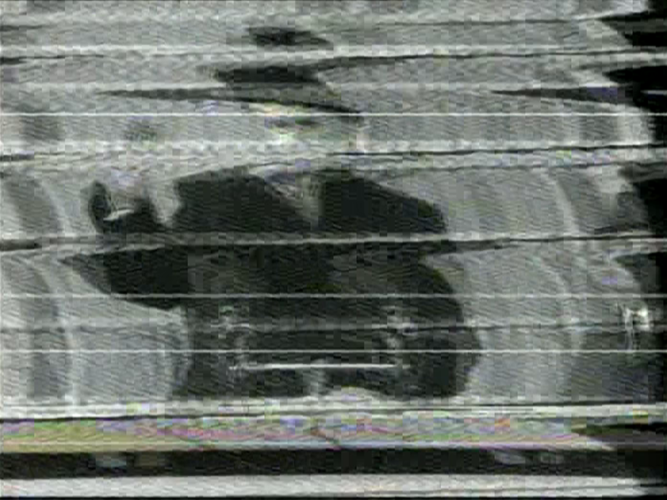
Videograms of a Revolution / Videogramme einer Revolution (d. Harun Farocki, Andrei Ujică, 1992)
Sure, and the story about Videograms in Romania is pretty weird. Well, not weird, you can see the reasons behind it. The film didn’t have good reception when it came out, it was too soon. Mr. Ujică recalls the first screenings[1] and it was a period when everybody wanted to find out “truths” about the Revolution – who shot who, who did what. And Videograms doesn’t do that at all. It gained a lot more visibility in the 2010s. Marius Babias is also the co-editor of Farocki’s memoir (Zehn, zwanzig, dreißig, vierzig. Fragment einer Autobiografie, n.b.k., 2017, translated into Romanian by Christian Ferencz Flatz for Idea Design & Print in 2019 – r.n.), and you’re the other one.
It’s the first translation. You’d think the first one should be English, but this time it is in Romanian.
More than half of the works presented here are co-directed by you. I had a little chat with Diana (Marincu) and told her that I see her approach as being a corrective one. She agreed. In the sense that when certain people get as big as Farocki, film history, its narrative, tends to forget the people around them.
Sure, there’s a post-agenda issue inscribed into it. Women are very often removed from film history, all these white old men one after the other… It’s even the case with Jean Marie Straub and Danièle Huillet, you know? How is this even possible if they were signing their work together? In Harun’s case, it’s interesting because he was so loyal to his team. He collaborated over decades with the same cameraman, Ingo Kratisch. The same with our technical director and researcher, Jan Ralske. Christian Petzold, with whom he wrote many scripts, and people like me; we lived and worked together for almost two decades. In the creative field you cannot really separate life and work. It makes me happy that people like Diana respect this. Even graphically, Harun’s name is always very big and there’s “in collaboration with”. I’m so used to it by now, this strange problem will never be solved.
While reading your introduction to his memoir I came across this brief description of your relationship with Harun, “love, work and cinema”. Much of your and Farocki’s work is, well, about work. And his shifts from one medium to another are symptomatic in a way for how working in the audiovisual field has changed during the years. From cinema to television, video, installation, etc. You were constantly under the pressure of finding money for your work.
It is a small history of media production in Germany, very related to the decline of public television. It wasn’t our decision to become artists and go towards the art world. It happened. Suddenly, submissions and funding were better here. We weren’t aware at the beginning of how big this would be, that we would be involved in biennales and documentas. But we were very happy about it. After the struggle of cinema financing, it was so cool to see that museums don’t expect that 20-page exposé and camera concept (!) for a documentary film. Also, I remember the premiere of Videograms of a Revolution in Berlin. There were two people there, can you imagine? Two! (laughing). If you have a show at MoMA you have thousands and thousands going in and out every day. It sounds terrible, I know. But all in all, the media production was favorable for us.
What do you think is exciting for people about the spatial cinephilia provided by installations?
There’s a difference between talking about our work and video art in general. Video art became very popular in the late 90s. More artists were producing it, especially people who had no filmmaking background. And now everybody has a phone and films something. The quality is often terrible, but on the other hand, people are getting better and better, more and more skills are being democratized. However, I still don’t think it can be compared to what Pedro Costa is doing (as a video artist). James Benning is also being shown more often in art spaces. The same with Harun, but he comes with this heavy work, not at all atmospheric. Sure, the art world is often vain and superficial. And this was his luck, because some people were sick of this loss of intensity, of beautiful and colorful work. Harun’s work is about something, you have to follow it, it’s not boring.
His installations are especially interesting because he started as an agitprop filmmaker and from there he developed a more sophisticated political approach. Do you think there’s more potential in the medium of installations to present political films or video art? It implies a much more active way of looking.
There is potential. When you do something for cinema there is a set of expectations you have to fulfill – when people go to the cinema, they expect something and they get it. You have a formula. The exhibition rule is really the contrary; in principle, you can do whatever you want and people are ready. You don’t have to settle things there. By the end of the nineties, there was this phenomenon, these research-exhibitions came up. Not just exhibitions with art, but exhibitions which dealt with specific themes, but in the medium of art. Sometimes there was so much text. But this is the potential, to convey your content and interests into something more direct.
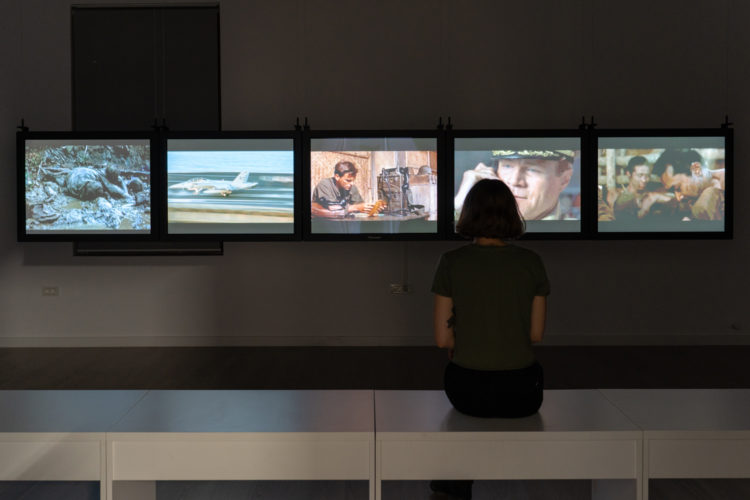
Exhibition view, Harun Farocki & Antje Ehmann, War Tropes / Tropen des Krieges ( 2011, five-channel video installation, B/W and color, with sound, 35’. Photo credit: infi.ro
It’s funny that you mention text in exhibitions. Just earlier I was thinking that too much text would ruin a Harun Farocki one.
I don’t like it either, I always say that when and if I’m asked. Especially if it’s visual art, all these explanations, you can Google! Whenever I make exhibitions, they don’t have too much text. Why don’t you make a book instead of putting it on a wall? I’m not saying this because I don’t value text or literature. On the contrary, I value it so much that I think it should be on its own.
You and Harun had different versions for some of your pieces – film-films and multi-screen installations. Which one works better in terms of soft montage?
I wouldn’t put one against the other. There is a difference. You can make an installation, two images next to each other, and you can make a film-film. But all in all, cinema works in a conventional way. Harun always dreamt of doing a film with two images since he saw Godard’s Numéro deux (1975). And he made it in cinema, but he also made it in the art world. And I wouldn’t say one is better than the other. Both made some things possible.
Is there an installation version of Videograms?
No.
But could there be one?
Of course it could, but it would be sensationalistic. You could cut the whole thing and show the material on monitors. But the beauty of Videograms to me is that it’s a reconstruction that goes with a chronology. As the events happen, you sit there and time goes by and you come closer and closer to the culmination, the death of the Ceaușescu couple. So you could split it in, let’s say, ten monitors aligned in an exhibition room and make a timeline. But then you would ask yourself why. I would not be convinced. But it would be interesting to ask Andrei (Ujică).
The Autobiography was once exhibited in Brussels. Do you get this feeling that a lot of films find a second life in exhibitions, but in a bad way?
It’s such an easy way to bring some money in the house.
But isn’t it contributing to this general feeling that there’s a lot of plastic in the art world?
Films are not video art, that should be clear. But there are museums with cinemas included. MoMA was one of the first.
Sure, but screening a film on a wall?
I don’t like it. I always check if there’s a good reason to do it because of the film’s content. And also, how it is presented. Sometimes people are so careless, they have the name, the title, but it’s not about cinema or the film, just name dropping.
Do you think Farocki’s legacy is more embraced by the art world?
Not really. Film festivals like to include works by Harun whenever they organize a retrospective. Also, officially, we restored and digitized all of Harun’s work and it took us 8-10 years. There is this funny thing in Germany, you have to be on this special list made by the Cinemateque and others. If a title of yours is on that list you can apply for money to restore it. From time to time, one of Harun’s films would pop up on one of those lists. But since cinema is an endangered species, his work is more vivid in the art world, but also in academia.
A lot of people are doing video essays right now. Do you know this scene? Kevin B. Lee, for example, who was also a residency fellow at the Farocki Institut.
I totally admire Kevin B. Lee, what he does is so inventive and nerdy. But his work is not like all the others, right?
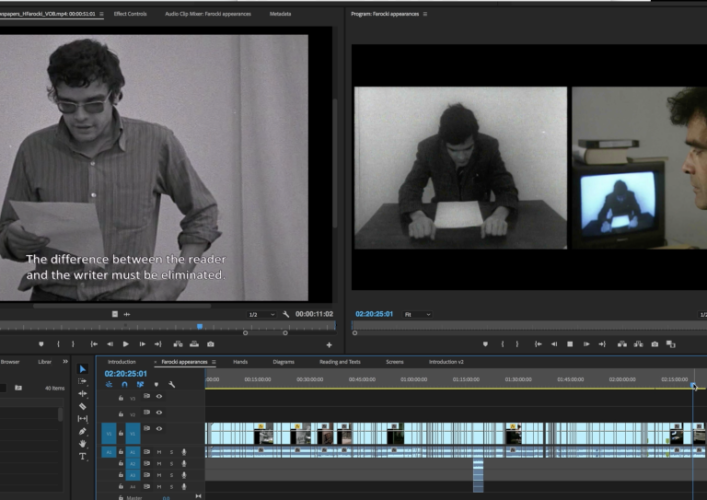
Harun Farocki: The Counter-Image (d. Kevin B. Lee, 2018)
He is one of the bright ones, sure. But it’s interesting because the essay film, Farocki, Marker, Third Cinema….
The white old men, yeah, telling it with their voice and a special poetry. And now since technique is so handy, people take some images and text and call it essay film.
I mean… On the internet it’s an emerging medium.
I hope it gets better and better. But it’s the same with video artists, video mapping. You really have to say something, you know? It’s not about my feelings and the world, I think it’s very, very difficult to make a really good essay-film because it has to be about something. And it’s very tempting to make some atmospheric images with some kind of poetic touch; one idea, fifteen minutes. It shouldn’t sound arrogant when I say that. Once again, I just respect the medium so much that I wish people would also respect it more. But I could also say the contrary, there are so many examples of beautiful films being made. One subgenre of the essay-film that I totally love is the photo-film. You have to take every image into account and figure out how to make a story, it’s wonderful. Maybe I’m a bit conservative, purist.
Your piece on De Niro, sure, you can call it video art, but I would totally call it a video essay with no narration.
It’s so simple.
A fun fact about dubbing here in Romania is that we had a black market of VHS in the second half of the ’80. What’s really interesting is that most of the action films were dubbed by this translator from the National Television, Irina Nistor. And she had this squeaky voice that went over the lines of Chuck Norris, Schwarzenegger, the big toxic guys. In a way, she was castrating them.
So funny.
Did you choose the languages (German, French, Italian and Spanish) out of many?
These are the ones we found. Maybe there are more in this world. Of course, you can imagine we were not fond of dubbing. But it’s interesting if you get into it, you come to realize even the soundtrack is different. Sometimes the clock ticks differently. And you see De Niro, and you associate him with one voice all the time. We have a guy who always dubs De Niro in German, the same guy. We made this piece in the context of an exhibition called Cinema like never before (2006). Everybody was supposed to show something about cinema, cinema history, the shift from cinema to art spaces. It wasn’t even meant to be a piece in itself, but surrounded by others.

Synchronisation / Dubbing (r. Harun Farocki, Antje Ehmann)
For me, it’s very much about how machismo sounds in more languages. You know, the general politics of dubbing – we need certain voices to be good, bad, masculine, feminine…
Yeah, gay, lesbian.
Sure. And then there’s another side of politics to it. What’s dubbing if not a nationalist ambition? What can be said about a country where dubbing becomes law? We use dubbing only for cartoons now.
And it’s also an economic thing. You say you don’t have dubbing in Romania. Of course, it’s so expensive, only super-rich countries would do it. The whole thing is so crazy, it’s amazing that it actually works. But these are rich countries, countries with high literacy. Why would it be a problem for them to read subtitles on their own? It’s also some kind of laziness.
But the absence of dubbing is also very political. Back in the nineties and early 2000s, my generation grew up watching American cartoons without any kind of dubbing or subtitles. I wasn’t learning English back then, but…
And did it work?
To some degree. Kids learn fast. But it was a lot of colonization going on there.
In Germany we had kids learning English because of the Harry Potter series. The translations took a while so they managed on their own. It’s a phenomenon, part of pop culture.
Sure, but it shows a lot of the domineering side of English. I remember Farocki wrote something about his anxieties of speaking English while in New York. Tell me a bit about the concept behind Labour in a Single Shot.
This was a dream project. Harun had the idea while teaching in Vienna, the first try was with his students. After his retirement, we thought we could do it together because we had all these invitations to show films. But most of the time it was him who was invited. So, we had to design the concept of the project and every time we would get an invitation, we mentioned that we would like to come and do something related to Labour in a Single Shot as well. Initially, we planned 15 workshops worldwide, on all continents. The people from Goethe Institut contacted us and said that the project is great but we would never manage, it’s too big and complicated. But we did it, and we owe a lot to Goethe. When Harun died, I was not able to go on for three years, I just couldn’t imagine doing it without him. But then a younger filmmaker (Eva Stotz), approached me and it was ideal.
What do you think is the general idea about labor that your project reads?
The beauty of it is that it doesn’t show one thing, it’s a growing archive and you can make your way through it. The topic is so big, even if the strict format – one shot, two minutes, no cuts – makes it selective.
Is In Comparison (2009), Farocki’s film from 2009, the forerunner of the project?
I think you can go even earlier. The topic of labor was always there in his work, among others, which you can follow through his texts, films, installations – war, labor, technology, the dynamics between humans and machines. The beauty of this project is to do it collaboratively, to have the tool of comparison. You can compare conditions here and there, it’s so rich and interesting to see different stages of industrialization and modernity, amazing skills of doing things without a lot of tools. It’s so vast, so exciting to find out about something you didn’t even know it exists.
Did you ever work outside the creative field?
Not really. As a student, I worked for a film festival, but that doesn’t count. I’m happy to say that, I think, if you work passionately it’s very much about collaboration. So, you remain in touch with reality. You don’t just sit at a desk and conceive something. Harun and I also worked a lot in documentary, which basically deals with reality.
[1] The very first screening of the film in Romania took place at Goethe Institut in Bucharest.
POSTED BY
Călin Boto
Călin Boto is the editor-in-chief of the cinema magazine Film Menu and the coordinator of its weekly film club. As a freelancer, he collaborates with several publications and film festivals, includin...


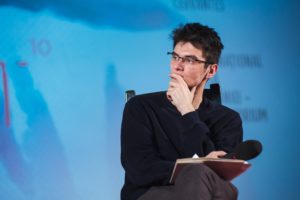
Comments are closed here.